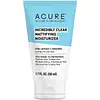What's inside
What's inside
 Key Ingredients
Key Ingredients

 Benefits
Benefits

 Concerns
Concerns

 Ingredients Side-by-side
Ingredients Side-by-side

Water
Skin ConditioningCitrullus Lanatus Seed Oil
EmollientSqualane
EmollientTriolein
Skin ConditioningMusa Sapientum Leaf Extract
Skin ConditioningGlycerin
HumectantBetaine
HumectantCetearyl Olivate
Butyrospermum Parkii Butter
Skin ConditioningCrambe Abyssinica Seed Oil Phytosterol Esters
EmulsifyingGlyceryl Stearate Se
EmulsifyingJojoba Esters
EmollientSelaginella Lepidophylla Extract
EmollientCetearyl Alcohol
EmollientCetyl Palmitate
EmollientSorbitan Olivate
EmulsifyingNicotiana Benthamiana Hexapeptide-40 Sh-Polypeptide-76
Skin ConditioningButylene Glycol
HumectantSalix Alba Bark Extract
AstringentGenipa Americana Fruit Extract
Skin ConditioningSorbitan Palmitate
EmulsifyingSorbitan Oleate
EmulsifyingXanthan Gum
EmulsifyingCitric Acid
BufferingWater, Citrullus Lanatus Seed Oil, Squalane, Triolein, Musa Sapientum Leaf Extract, Glycerin, Betaine, Cetearyl Olivate, Butyrospermum Parkii Butter, Crambe Abyssinica Seed Oil Phytosterol Esters, Glyceryl Stearate Se, Jojoba Esters, Selaginella Lepidophylla Extract, Cetearyl Alcohol, Cetyl Palmitate, Sorbitan Olivate, Nicotiana Benthamiana Hexapeptide-40 Sh-Polypeptide-76, Butylene Glycol, Salix Alba Bark Extract, Genipa Americana Fruit Extract, Sorbitan Palmitate, Sorbitan Oleate, Xanthan Gum, Citric Acid
Water
Skin ConditioningAloe Barbadensis Leaf Juice
Skin ConditioningGlyceryl Stearate Citrate
EmollientCetearyl Alcohol
EmollientGlyceryl Caprylate
EmollientHelianthus Annuus Flower
Skin ConditioningCarthamus Tinctorius Flower
MaskingTheobroma Cacao Seed Butter
EmollientCocoglycerides
EmollientGlycerin
HumectantSodium Levulinate
Skin ConditioningPotassium Sorbate
PreservativeGlyceryl Laurate
EmollientTocopherol
AntioxidantOlea Europaea Fruit Oil
MaskingCalendula Officinalis Flower Extract
MaskingTocopheryl Acetate
AntioxidantOenothera Biennis Oil
EmollientUbiquinone
AntioxidantArgania Spinosa Kernel Oil
EmollientSyringa Vulgaris Meristem Cell Culture
AntioxidantMarrubium Vulgare Meristem Cell Culture
Skin ProtectingEchinacea Angustifolia Meristem Cell Culture
Skin ConditioningChlorella Pyrenoidosa Extract
Skin ConditioningEuterpe Oleracea Fruit Extract
Rubus Fruticosus/Idaeus Extract
Skin ConditioningPunica Granatum Extract
AstringentRosa Canina Fruit Extract
AstringentChamomilla Recutita Flower Extract
MaskingWater, Aloe Barbadensis Leaf Juice, Glyceryl Stearate Citrate, Cetearyl Alcohol, Glyceryl Caprylate, Helianthus Annuus Flower, Carthamus Tinctorius Flower, Theobroma Cacao Seed Butter, Cocoglycerides, Glycerin, Sodium Levulinate, Potassium Sorbate, Glyceryl Laurate, Tocopherol, Olea Europaea Fruit Oil, Calendula Officinalis Flower Extract, Tocopheryl Acetate, Oenothera Biennis Oil, Ubiquinone, Argania Spinosa Kernel Oil, Syringa Vulgaris Meristem Cell Culture, Marrubium Vulgare Meristem Cell Culture, Echinacea Angustifolia Meristem Cell Culture, Chlorella Pyrenoidosa Extract, Euterpe Oleracea Fruit Extract, Rubus Fruticosus/Idaeus Extract, Punica Granatum Extract, Rosa Canina Fruit Extract, Chamomilla Recutita Flower Extract
 Reviews
Reviews

Ingredients Explained
These ingredients are found in both products.
Ingredients higher up in an ingredient list are typically present in a larger amount.
Cetearyl alcohol is a mixture of two fatty alcohols: cetyl alcohol and stearyl alcohol. It is mainly used as an emulsifier. Emulsifiers help prevent the separation of oils and products. Due to its composition, it can also be used to thicken a product or help create foam.
Cetearyl alcohol is an emollient. Emollients help soothe and hydrate the skin by trapping moisture.
Studies show Cetearyl alcohol is non-toxic and non-irritating. The FDA allows products labeled "alcohol-free" to have fatty alcohols.
This ingredient is usually derived from plant oils such as palm, vegetable, or coconut oils. There is debate on whether this ingredient will cause acne.
Due to the fatty acid base, this ingredient may not be Malassezia folliculitis safe.
Learn more about Cetearyl AlcoholGlycerin is already naturally found in your skin. It helps moisturize and protect your skin.
A study from 2016 found glycerin to be more effective as a humectant than AHAs and hyaluronic acid.
As a humectant, it helps the skin stay hydrated by pulling moisture to your skin. The low molecular weight of glycerin allows it to pull moisture into the deeper layers of your skin.
Hydrated skin improves your skin barrier; Your skin barrier helps protect against irritants and bacteria.
Glycerin has also been found to have antimicrobial and antiviral properties. Due to these properties, glycerin is often used in wound and burn treatments.
In cosmetics, glycerin is usually derived from plants such as soybean or palm. However, it can also be sourced from animals, such as tallow or animal fat.
This ingredient is organic, colorless, odorless, and non-toxic.
Glycerin is the name for this ingredient in American English. British English uses Glycerol/Glycerine.
Learn more about GlycerinWater. It's the most common cosmetic ingredient of all. You'll usually see it at the top of ingredient lists, meaning that it makes up the largest part of the product.
So why is it so popular? Water most often acts as a solvent - this means that it helps dissolve other ingredients into the formulation.
You'll also recognize water as that liquid we all need to stay alive. If you see this, drink a glass of water. Stay hydrated!
Learn more about Water